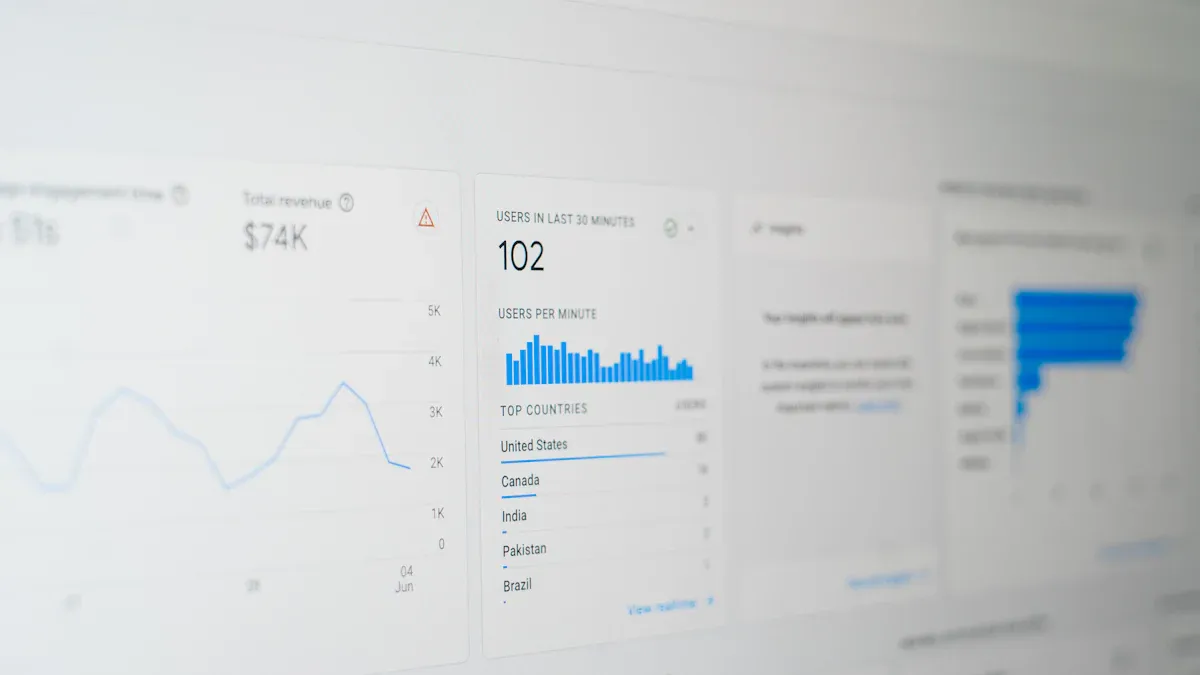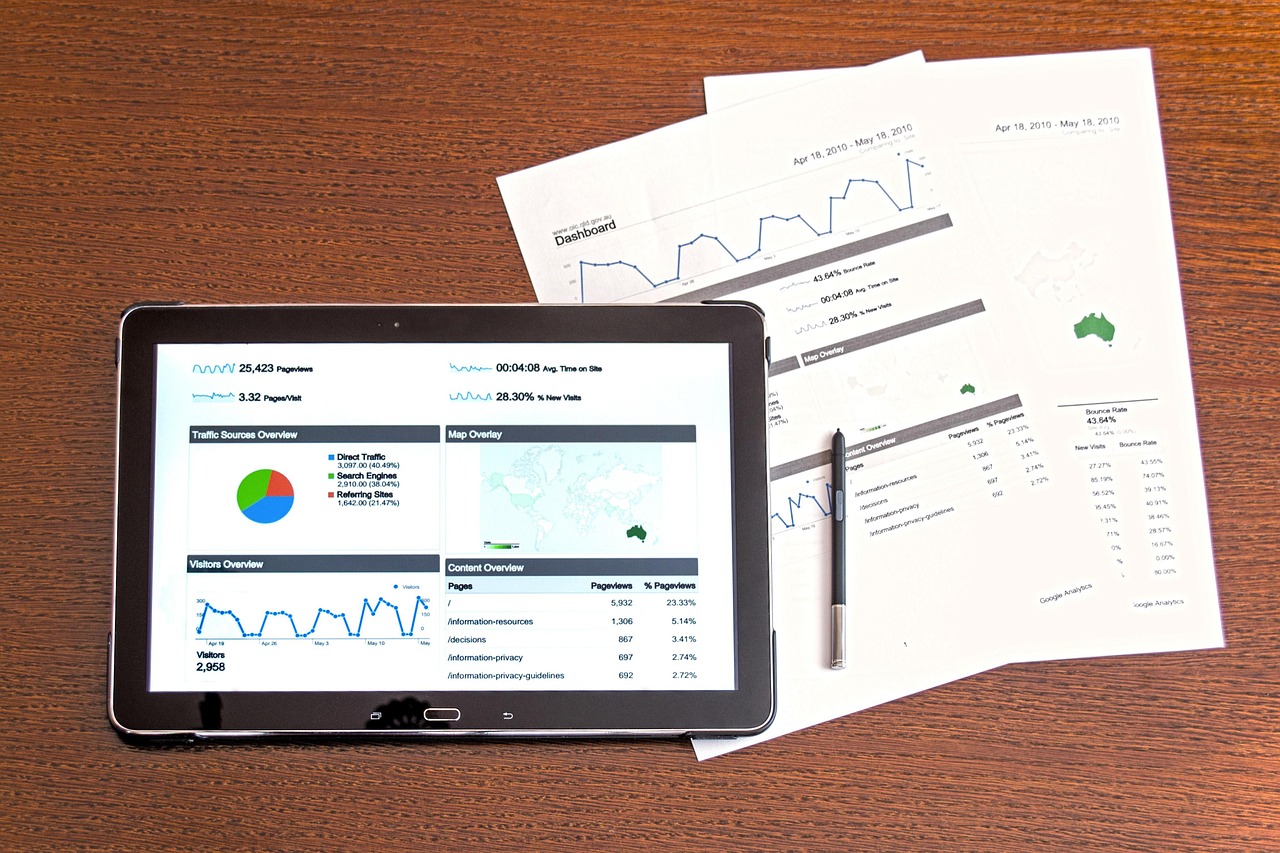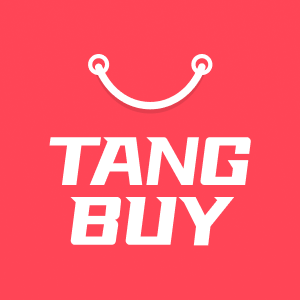The Smart Seller Dashboard: How AI Turns Data into Daily Decisions

You want to make better business decisions every day, right? The Smart Seller Dashboard gives you the power to do just that. With all your sales and marketing data in one place, you can spot trends and patterns without needing expert skills.
You see everything from multiple platforms at a glance
You get instant, easy-to-understand analysis
You ask questions in plain English and get clear answers
This means you spend less time searching for information and more time taking action.
Key Takeaways
The Smart Seller Dashboard puts all your sales and marketing data in one place. This makes it easy to see trends and patterns. Real-time updates mean you always have the newest data. This helps you make faster and smarter choices. You can change the views to see the most important metrics for your business goals. AI helps find patterns and guess future trends. This means you do not have to guess about inventory and pricing. Dynamic pricing lets you change prices fast when the market changes. This helps you earn more money. The dashboard makes data analysis simple. You can ask questions in plain English and get clear answers. Checking key performance indicators (KPIs) often helps you see how you are doing. It also shows where you can get better. Getting your team to help set up and learn the dashboard builds confidence. It also makes sure everyone can use the dashboard well.
Smart Seller Dashboard Overview

The Smart Seller Dashboard puts you in control of your business data. You get a single place to see what matters most. This dashboard helps you make sense of numbers, spot trends, and act fast. You do not need to be a data expert. The dashboard does the hard work for you.
Key Features
You want tools that make your day easier. The Smart Seller Dashboard gives you just that. Here are the top features you will find:
Clear and Easy to Understand: You see your data in colourful graphs and charts. Filters help you focus on what matters.
Real-Time Data or Frequent Updates: You always work with the latest numbers. No more guessing or waiting for reports.
Customisable Views: You choose which numbers and charts you want to see first. The dashboard fits your goals.
Centralised Data Integration: You connect all your sales channels and platforms. Everything shows up in one place.
Profit-Focused Insight: You see what drives your profits, not just surface-level numbers.
Tip: Use the custom filters to zoom in on your best-selling products or spot slow movers.
How It Works
You might wonder how the Smart Seller Dashboard turns raw data into clear actions. The answer is simple. The dashboard pulls in data from all your platforms. It then uses smart tools to clean up the numbers and show you what matters.
Feature | Benefit |
|---|---|
You spot trends and make decisions quickly | |
Dashboards | You get a full view of your key metrics |
Alerts | You get notified when something changes fast |
Bulk Editing | You manage many products with just a few clicks |
You interact with the dashboard in real time. You can ask questions in plain English. The dashboard gives you answers you can use right away. It predicts what might happen next and suggests actions. You get a dashboard that learns what you care about and shows you the right information.
The Smart Seller Dashboard helps you move from guessing to knowing. You spend less time searching and more time growing your business.
AI Capabilities

Data Integration
You want all your business data in one place. The Smart Seller Dashboard makes this easy. It pulls information from every sales channel, website, and even your marketing tools. You do not have to jump between apps or spreadsheets. Everything comes together in a single view.
Many dashboards use smart tools like Tableau, Microsoft Power BI with Copilot, and Domo AI. These tools help you see trends across different products and locations. You can ask questions and get instant answers. Some dashboards, like Sisense Fusion, even connect with your CRM, so you see customer details and sales numbers side by side.
Tip: When you connect all your data sources, you spot gaps and new opportunities much faster.
Pattern Detection
You do not want to miss out on hidden trends. AI in your dashboard looks for patterns you might not see on your own. It checks your sales, customer visits, and even supply chain updates in real time. You get alerts if something changes fast, like a sudden drop in stock or a spike in demand.
Here’s what AI can do for you:
Spot supply chain issues before they become problems.
Forecast demand surges so you know when to restock or run a promotion.
Analyse past sales and customer behaviour to predict what will sell next.
Adjust prices on the fly to boost profits or clear out slow-moving stock.
You do not have to dig through reports. The dashboard highlights what matters, so you can act quickly.
Predictive Insights
You want to know what will happen next, not just what happened yesterday. AI-powered dashboards give you this edge. They use machine learning to study your data and make smart predictions. You get advice on what to stock, when to run a sale, and how to price your products.
Let’s compare how AI stacks up against old forecasting methods:
Method | Accuracy |
|---|---|
Traditional Forecasting | Lower accuracy due to reliance on past trends and fixed assumptions. |
AI-Powered Forecasting | Higher accuracy as AI continuously learns and refines predictions. |
AI-driven dashboards can predict sales outcomes with up to 85% accuracy. They keep learning from new data, so their advice gets better over time. You spend less time guessing and more time making decisions that grow your business.
Note: With predictive insights, you can plan ahead and avoid costly mistakes.
Seller Use Cases
You want to know how the Smart Seller Dashboard helps in real life. Here are some simple examples that show how you can use it every day.
Inventory Management
It is hard to keep the right amount of stock. If you have too much, you waste money. If you have too little, you lose sales. The Smart Seller Dashboard helps you find the right balance.
Stock Optimisation
Smart tools help you track your stock everywhere. The dashboard shows what sells and what does not. You get alerts if stock is low or if you have too much. This helps you fix problems before they get worse.
Here is how different industries use smart dashboards for inventory:
Industry | Example Description | Impact on Inventory Management |
|---|---|---|
Hospital | Uses smart sensors to track medical supplies and reorder based on usage patterns. | Reduced stockouts by 90%, cut inventory costs by 20%. |
Logistics Company | Optimises product storage across warehouses in real-time based on various factors. | Cut transportation costs by 15%, improved delivery speed. |
Car Manufacturer | Monitors parts inventory in real-time and adjusts production schedules accordingly. | Reduced inventory costs by 25%, improved production efficiency. |
Clothing Retailer | Tracks inventory across stores and online, fulfilling orders from the nearest stock. | Reduced stockouts and minimised excess inventory markdowns. |
These examples show how you can waste less and earn more.
Demand Forecasting
You want to know what customers will buy soon. The dashboard uses AI to look at old sales and spot trends. You get forecasts that help you order the right things. You do not run out of popular items or buy too many slow sellers.
It restocks for you, so you do not miss sales.
Real-time updates help you react fast to changes.
Keeping stock levels right means you do not lose sales.
Less extra stock means more money for other things.
Better control of stock helps you earn more from your business.
Tip: Use demand forecasts to plan your sales and avoid last-minute problems.
Dynamic Pricing
You want your prices to match the market. The Smart Seller Dashboard helps you change prices quickly and easily. You can see what others charge and change your prices to stay ahead.
Sector | Description |
|---|---|
Travel | AI-driven dynamic pricing automates changes, making prices more accurate and saving time. Automation works for many hotels or flights, so you keep up with demand and rivals. |
eCommerce | Top eCommerce teams use agentic AI to spot changing customer habits and set prices for electronics. Automated checks find ways to grow and set new standards for delivery. |
You do not need to guess. The dashboard helps you set prices that bring in buyers and keep your profits safe.
Customer Insights
You want to know what your customers like and how they shop. The Smart Seller Dashboard gives you real-time customer data. You see which products are popular and which adverts work best.
You get instant customer data, so you can change your marketing fast.
You pick which numbers to watch, helping you reach your goals.
Sharing data means everyone uses the latest information.
Clear reports show which adverts work, so you can do it again.
Note: Use customer insights to make your offers personal and build better relationships.
You can use these ideas to make better adverts, improve your products, and keep customers coming back.
Benefits by Role

Planners
You want to stay ahead of the curve. As a planner, you need to spot trends before they become problems. The Smart Seller Dashboard helps you do just that. You see all your data in one place, so you can plan stock, campaigns, and budgets with confidence. You do not have to guess what will happen next. The dashboard shows you patterns and gives you forecasts. You can adjust your plans quickly if something changes.
You get clear charts and alerts, so you know when to act.
You can test different scenarios and see what works best.
You save time by not jumping between spreadsheets.
Tip: Use the dashboard’s filters to focus on your top products or regions. This helps you plan smarter and avoid surprises.
Decision-Makers
You make the big calls. You want to know what is working and what needs to change. AI-powered dashboards help you move from looking back to looking forward. You see trends and causes, not just numbers. This means you can make decisions before problems grow.
AI dashboards give you real-time insights and spot patterns fast. You get a single view of how every part of your business is doing. This makes it easier to work with other teams and share ideas. Many leaders say that dashboards help them decide faster and with more confidence.
You see what is driving your results, so you can act quickly.
You get updates as things happen, not days later.
You can share clear reports with your team.
Did you know that Airbnb used an AI-powered recommendation engine and saw a 15% jump in conversions in just six months? This shows how using AI in your daily work can boost your results.
Most companies want to invest more in AI. Still, only a few feel they are using it well. Many leaders find dashboards tricky because of complex data. The right dashboard makes things simple and helps you get the most from your data.
Frontline Teams
You are on the shop floor or talking to customers every day. You need tools that help you work faster and make fewer mistakes. The dashboard gives you instant updates, so you always know what is in stock or what needs attention.
Here is what teams have reported after using dashboards:
Improvement Type | Reported Outcome |
|---|---|
Error Correction Time Reduction | |
Report Accuracy Increase | More accurate reports |
Time Recovery for Revenue Tasks | 11+ hours saved each week for sales activities |
You spend less time fixing errors and more time helping customers. You can focus on what matters most—growing sales and keeping shoppers happy.
Human-AI Partnership

You might wonder how you and AI can work together every day. The truth is, you both bring something special to the table. When you combine your experience with the speed and power of AI, you get the best results. Let’s look at how this partnership works.
AI Strengths
AI can do things you simply cannot do as fast or as often. It helps you work smarter, not harder. Here’s what AI does best:
AI processes huge amounts of information in seconds. You get answers quickly, so you can keep your sales conversations sharp and focused.
AI spots patterns in your data. You see trends you might miss on your own. This helps you make better decisions and improve your sales strategies.
AI takes care of boring, repetitive tasks. You save time and can focus on the big picture, like building relationships or planning your next move.
Tip: Let AI handle the heavy lifting with data, so you can spend more time on creative and strategic work.
Human Contribution
You bring skills that AI cannot match. Your judgement, creativity, and personal touch make all the difference. Here’s how you add value:
You understand your customers’ feelings and needs. AI can show you the numbers, but you know what makes people tick.
You use your experience to spot when something feels off, even if the data looks fine.
You build trust with your team and your customers. People want to talk to a real person, not just a screen.
You ask the right questions. Sometimes, the best ideas come from a simple chat or a quick brainstorm.
You and AI work best as a team. You guide the dashboard, and it gives you the insights you need.
Building Trust
You might feel unsure about trusting AI at first. That’s normal. Trust grows over time as you see results and get comfortable with the tools. Here’s how you can build trust in your AI dashboard:
Choose dashboards with simple, clear interfaces. You want tools that are easy to use, no matter your tech skills.
Make sure everyone can access the dashboard. The best tools work for all team members, not just the tech experts.
Give feedback often. Good dashboards improve when you share your thoughts and ideas.
Look for leaders who use the dashboard and encourage others to do the same. When you see results, your confidence grows.
Remember, quality data matters. If you put in poor data, you get poor results.
Note: Trust also comes from transparency. When you know how your AI makes decisions, you feel more confident using it.
You build trust by using the dashboard every day, seeing the benefits, and knowing your data is safe. Over time, you and your team will rely on AI as a trusted partner in your business.
Implementing the Smart Seller Dashboard

Getting Started
You want to get the most out of your data, but you might not know where to begin. Start by looking at your current setup. Ask yourself what you want to achieve. Do you want to track sales, manage stock, or understand your customers better? Write down your main goals. This step helps you stay focused as you move forward.
Next, check if your data is ready. Make sure your sales, inventory, and customer information are up to date. Clean data gives you better results. If you spot any gaps, fill them in now. You do not need to do everything at once. Take small steps and build up your dashboard over time.
Tip: Involve your team early. Ask them what information they need most. This makes everyone feel part of the process and helps you choose the right features.
Tool Selection
Choosing the right tool can feel tricky, but you have plenty of options. Look for a dashboard that matches your goals and fits your budget. Some popular choices include Shopify Magic, Mipler, and Anaplan. Each tool offers different features, so think about what matters most to you.
Shopify Magic works well for online shops. It helps you track sales and spot trends.
Mipler gives you detailed reports and easy-to-use charts.
Anaplan is great if you want to plan and forecast across your whole business.
When you compare tools, check if they connect with your current systems. You want a dashboard that pulls in data from all your sales channels. Try out free trials or demos if you can. This helps you see which tool feels right.
Here are some common challenges sellers face and how you can solve them:
Challenge | Solution |
|---|---|
Data Engagement Gap | Co-creation with end-users |
Lack of Trust | Building transparency and understanding |
Poor User Experience | Ensuring a seamless and intuitive interface |
Irrelevant Metrics | Aligning metrics with user goals |
Inadequate Training and Support | Providing comprehensive onboarding and support |
Team Training
You want your team to feel confident using the new dashboard. Start with a simple training session. Show everyone how to log in, find key reports, and use filters. Keep things hands-on. Let your team try out the features themselves.
Offer support as your team learns. Answer questions and share tips. If someone struggles, pair them with a team member who learns quickly. Encourage everyone to use the dashboard every day. The more they use it, the easier it gets.
Note: Good training helps your team trust the dashboard and use it to make better decisions.
The Smart Seller Dashboard works best when everyone feels comfortable and knows how to use it. With the right start, tool, and training, you set your business up for success.
Measuring Success
You want to know if your Smart Seller Dashboard is working for you. Measuring success helps you see the real impact on your business. You can track progress, spot areas for improvement, and celebrate wins. Let’s look at how you can do this in a simple way.
Start by setting clear goals. What do you want to achieve with your dashboard? You might want to boost sales, cut costs, or improve customer satisfaction. Write down these goals so you know what to measure.
Next, choose the right key performance indicators (KPIs). KPIs show you if you are moving in the right direction. You can track numbers like sales growth, profit margins, or customer retention. The dashboard makes it easy to see these figures every day.
Here’s a table that shows some common KPIs and what they mean for your business:
KPI Type | Description |
|---|---|
Measures how effectively company funds are used. | |
Sales Growth | Tracks how much your sales increase over time. |
Inventory Turnover | Shows how quickly you sell and replace stock. |
Customer Retention | Tells you how many customers come back. |
Profit Margin | Reveals how much money you keep after costs. |
You can use these KPIs to check if your dashboard is helping you reach your goals. For example, if your ROI goes up, you know your investment is paying off. If sales grow and more customers return, you see real progress.
Set a regular time to review your results. You might check your dashboard every week or month. Look for patterns and ask yourself what is working well. If you spot a problem, use the dashboard to dig deeper and find solutions.
Tip: Share your results with your team. When everyone sees the numbers, you can work together to improve.
You can also use feedback from your team and customers. Ask them what they like about the dashboard and what could be better. Their ideas help you make changes that matter.
Keep things simple. Focus on the KPIs that match your goals. Do not try to track everything at once. When you measure success in a clear way, you make smarter decisions and grow your business faster.
Future Trends

Innovations
You want to know what is coming next for Smart Seller Dashboards. The future is exciting, with new tools making your work easier every day. Here are some of the newest things you will see:
Automated tools will find ways to make your product listings better. You will get tips to help more people see your products and buy them.
Biometric data and behaviour checks will help you spot fake products. This keeps your brand safe and protects your customers.
New systems will make shipping much simpler. You will find it easier to send orders and pick the best packaging. This saves you both time and money.
Voice features are on the way. Soon, you can use your dashboard without touching it. This means you can do more things at once and work faster.
Predictive analytics will become even smarter. You will see trends before they happen, so you can act early and stay ahead.
AI will help you make every customer feel special. You will send the right offers and help at the right time.
Boring jobs will be handled by AI. You can spend more time growing your business.
You will make decisions faster. AI-powered analytics will give you answers when you need them.
Dynamic pricing will get better. Your dashboard will change prices in real time, based on what others do and how customers act.
Tip: Watch out for these new features. They will help you work smarter and save time.
Adapting to Change
You might wonder how to keep up as AI changes quickly. The good news is you are not alone. Sellers everywhere are learning to use these new tools and do well.
Many sellers now use agentic AI. This means your dashboard can make some choices for you, so you do not have to watch everything. Companies like Hain Celestial and Speedy Hire already use these tools to change how they work.
You will see dashboards move from old styles to proactive AI. Your dashboard will not just show numbers. It will help you fix problems and make choices, even when things get tricky.
“This new era in AI technologies, built on large language models, offers unprecedented potential for businesses to increase their own performance... Our agentic AI solutions give our customers the ability to optimise and automate every complex commercial decision in their business.” – Richard Potter, CEO of Peak
You can start with just one new feature. As you get used to it, you will see how these changes help you stay ahead. The future of selling is about working with AI, not against it. You will find that changing is easier than you think, especially when you see good results.
You can make smarter choices every day with the Smart Seller Dashboard. You see clear data, save time, and help your team work better.
You boost profits and keep customers happy
You spot trends before they become problems
You stay ahead in a fast-changing market
Ready to take the first step? Try the dashboard and see how AI shapes your future in business.
FAQ
How do I connect my sales channels to the Smart Seller Dashboard?
You can link your sales channels with a few clicks. Most dashboards guide you step by step. If you get stuck, check the help section or ask your provider for support.
Will AI replace my job or my team?
No, AI will not replace you. It helps you work faster and smarter. You still make the big decisions. AI handles the boring tasks, so you can focus on your customers.
Is my data safe when I use an AI dashboard?
Your data stays secure. Most dashboards use strong encryption and follow strict privacy rules. Always choose a trusted provider and check their security policies.
Can I use the dashboard if I am not good with technology?
Yes, you can! The dashboard uses simple menus and clear charts. You do not need special skills. Many sellers find it easy after a short training session.
How often does the dashboard update my data?
Most dashboards update your data in real time or every few minutes. You always see the latest numbers. You do not need to wait for daily or weekly reports.
What if I want to track a new metric?
You can add or change metrics in your dashboard settings.
Many dashboards let you customise views.
If you need help, contact support or check the user guide.
Can I try the Smart Seller Dashboard before I buy it?
Many providers offer free trials or demos. You can test features and see if the dashboard fits your needs. Look for a trial button on the provider’s website.

TangBuy: A Smarter Way to Dropship in 2025
If you're looking to stay competitive with dropshipping in 2025, speed and trend-awareness are key. TangBuy helps you stay ahead with real-time product trends, fast fulfilment, and factory-direct sourcing. With over 1 million ready-to-ship items, 24-hour order processing, and seamless Shopify integration, TangBuy makes it easier to test, scale, and succeed in today's fast-moving eCommerce landscape.
See Also
Sellers Can Unlock High Profits In The Smartwatch Market
Choosing Between Amazon And eBay For Your 2025 Business
2025 BigBuy Dropshipping Review: Insights And User Feedback

